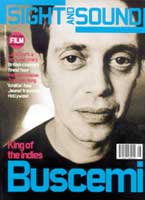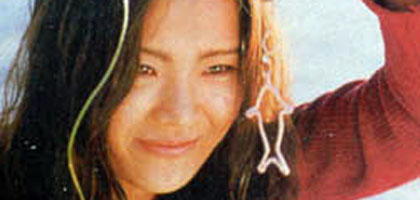
The Isle
Republic of Korea 2000

Reviewed by Richard Falcon
Synopsis
Our synopses give away the plot in full, including surprise twists.
A remote lake, South Korea. Hee-Jin (Seo Jeong), a young mute woman runs a shop from the lakeside, renting small floating fishing cabins to groups of male anglers and men with their mistresses. At night, Hee-Jin rows out to the huts and sells sexual favours. When one of the fishermen throws her payment into the lake, Hee-Jin dries out the money; the man is later pulled into the lake and drowns. Hyun-Shik (Kim Yu-Seok), a troubled young man, arrives and hires one of the huts. He has killed his wife and her lover after catching them having sex. Intent on suicide, his repeated attempts are interrupted - in one instance by a spike which is plunged through his boat by an unseen underwater figure, wounding him in the leg.
Hyun-Shik makes wire figures as gifts for Hee-Jin and a silent relationship develops between them. They begin to make love but Hyun-Shik is too aggressive, hurting her. She rings for Eun-A (Park Seong-Hee), a prostitute, and strands her on the hut with him. Hee-Jin has sex with a new arrival who is on the run from the police. The police arrive and arrest him. In despair, Hyun-Shik swallows a bunch of fish-hooks attached to a fishing line; Hee-Jin hides him from the police under the hut's toilet hatch. Hee-Jin then reels him in, removes the fish-hooks and has sex with him. Eun-A returns in her spare time to see Hyun-Shik. Jealous, Hee-Jin ties Eun-A up and leaves her in another hut; she later falls into the lake and drowns. Eun-A's violent pimp Mang-Chee (Cho Jae-Hyeon) comes looking for her and attacks Hyun-Shik. Hyun-Shik gets the better of him, and Hee-Jin drowns him in the lake. Hee-Jin and Hyun-Shik argue; he beats and rapes her. Hee-Jin inserts fish hooks into her vagina and throws herself into the lake. Hyun-Shik reels her in, removes the hooks and embraces her. Another couple arrives and take the hut where the bodies of Eun-A and Mang-Chee are sunk. The man's expensive watch is knocked into the water; called out to retrieve the watch, local divers recover the bodies. As the police arrive, Hee-Jin attaches an outboard motor to Hyun-Shik's hut and floats away.
Review
Seo Jeong, who plays Hee-Jin, the mute heroine of young Korean film-maker Kim Ki-Deok's international breakthrough movie, has said she hopes that in future the director will be able to "rise above the anger and inner pain of South Korea and its people and society and make something less visceral". What is initially most striking about The Isle for non-Korean viewers, though, is that its single setting - the pretty fishing huts that float on a beautiful, misty lake - precludes any sense of a wider society. The film's biggest achievement is to have devised such a distinctive location. In extended dialogue-free sequences, The Isle soothes us with the nocturnal isolation of the setting and silence, broken only by the splashing of Hee-Jin's oars on the water (she lives by the lakeside, and sells sexual favours to the male guests staying in the huts). The film flirts with poetry while the daylight shots are deliberately holiday-brochure pretty. On a practical level, the location obscures the fact that The Isle was made on a shoestring ($50,000, according to Kim Ki-Deok). On a critical level, as captivating as the location is, it frees up Kim Ki-Deok to manipulate his characters as he wishes. The location isn't a microcosm, it's an isolation device - each fishing hut the floating equivalent of The Big Brother house - with the promise of voyeuristic exploitation never more than a short boat ride away. The location - potentially a surreal landscape of the mind - degenerates instead into a picturesque equivalent of the American wilderness setting of many a straight-to-video slasher movie.
The Isle sees itself as "defying genre", but, like Takashi Miike's Audition, it's a gross-out movie in arthouse clothing. The Isle flaunts its imagery as bold surrealism while making sure it delivers its share of hooks 'n' hookers horror and sex. The shot of Hee-Jin reeling in Hyun-Shik, her on-off lover, like a human fish through the trapdoor of his hut, for example, is like the punchline of a contrived, convoluted joke. To service the shock images, character motivation is a matter of audience faith - leaving us free to see Hee-Jin as a latter-day equivalent to the mysterious title character of Hiroshi Teshigahara's 1963 Woman of the Dunes or, as Korean feminists have argued, as the embodiment of a fairly unreconstructed male sex fantasy (the laddish jokes in the film bear out the latter). It's an ambivalence maintained right up to the final arty image - which plays like Helmut Newton by way of Tarkovsky - in which the heroine's body literally becomes the landscape. Hyun-Shik's motivation in turn is provided by a flashback - as economically lurid as any manga comic - to a naked couple screwing, which cuts to their corpses being dragged through their own blood.
There's no gainsaying The Isle's success as exploitation - this case-hardened critic had to avert his eyes three times: when the hero repeatedly kicks the heroine in the crotch, when she begins inserting fish hooks into her genitals, and when he subsequently begins to reel her in using a rod. The traditional aspirations of arthouse cinema presuppose an engaged and patient audience, tolerant of difficulty. Kim Ki-Deok seems to have in mind an (emotionally at least) adolescent audience demanding regular shocks and bouts of barely defensible sexual violence to keep it interested. Like Audition, The Isle ultimately addresses us with a startling level of contempt and patronage. Its image of a character taking a shit towards the camera - something Lars Von Trier would regret neglecting - is perhaps talismanic for the expanding self-conscious paragenre of 'Extreme Cinema', increasingly supported by arthouse forms of distribution and exhibition.
The previewed version of the film also featured the mistreatment of animals: we saw, among other things, an angler slicing the flanks off a live fish and Seo Jeong later ripping apart a live frog. A central plank of the film's tiresome shock tactics - although in interviews Kim Ki-Deok attributes western protests to cultural difference - these sequences will, without doubt, be censored by the BBFC under the 1937 Cinematograph Films (Animals Act). You're on your own with the fish-hooks however.
Credits
- Director
- Kim Ki-Deok
- Producer
- Lee Eun
- Screenplay
- Kim Ki-Deok
- Hwang Seo-Shik
- Editor
- Kyoung Min-Ho
Director of Photography
